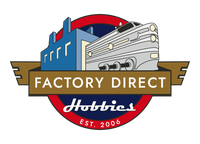PROTOTYPE SPECIFIC INFORMATION
In By the early 1960’s the Electro-Motive Division (EMD) was at a big disadvantage. Their 567 engine, in use for over 20 years, had reached it’s peak at 2,500 horsepower in a turbocharged 16-cylinder version. EMD released a new 645 engine in 1966. The most powerful locomotive using this series of engine was the SD45, powered by a 20-cylinder turbocharged 645E engine producing 3600 horsepower. EMD then offered the V20 645E engine in the SDP45 in a standard hood configuration and longer frame to occomodate the steam generator needed for passenger service. The EMD SDP45 was a good passenger locomotive, but to the Santa Fe Railway it did not look the part. EMD therefore designed a lightweight “cowl” body to cover the locomotive, though it did not, as in earlier cab units, provide any structural strength, which remained in the frame. The cowl provided sleeker looks, better aerodynamics at speed, and allowed the crew to enter the engine compartment en route for diagnostics and maintenance. After sponsoring the development of the FP45 passenger locomotive, the Santa Fe requested a similar freight locomotive from Electro-Motive. Where the FP45 was an SDP45 wrapped in a full-width Cowl carbody, the new F45 was essentially an SD45 given the same treatment.
In 1967, passenger service in the US was a dim prospect. Most roads were losing money on the trains, and looking for any reason they could think of to abandon service. The Burlington, however, was in a unique position. Not only did they constitute one-third of the conglomerate that hosted the world-famous California Zephyr, but they also operated a substantial commuter service in the Chicago area. To that end, the Q ordered three EMD FP45 locomotives in 1967 (two to power the CZ, and one as a reserve). They reasoned that, should the CZ falter, these units could easily be adapted to commuter service. * * This is an alternate timeline; unfortunately, the CB&Q did not purchase EMD FP45 locomotives. However, we think that they would look great in passenger service hauling the California Zephyr from Chicago to Denver, or heading up a fleet of bi-levels in commuter service - with these Legendary Liveries units, you can.
F45 SERIES LOCOMOTIVE FEATURES:
- Full cab interior
- Wire grab irons
- Coupler cut levers
- See-through cab windows
- Flexible rubber trainline hose
- Flexible rubber MU hoses
- Lift rings
- Windshield wipers
- Walkway tread
- Flush mounted port hole window glass
- Flexicoil-C sideframes with high brake cylinders
- Body-mounted McHenry® operating scale knuckle couplers
- DCC-ready features Quick Plug™ plug-and-play technology with 21-pin NEM connector
- Fine-scale Celcon handrails for scale appearance
- Detailed fuel tank with fuel fillers, fuel gauges, and breather pipes
- Genesis driveline with 5-pole skew wound motor, precision machined flywheels, and multi-link drivetrain
- All-wheel drive with precision gears for smooth & quiet operation
- All-wheel electrical pickup provides reliable current flow
- Wheels with RP25 contours operate on all popular brands of track
- Bidirectional LED lighting
- Heavy die-cast frame for greater traction and more pulling power
- Scaled from prototype resources including drawings, field measurements, photographs, and more
- Accurately-painted and –printed paint schemes
- Fully-assembled and ready-to-run
- Packaging securely holds model for safe storage
- Minimum radius: 18” — Recommended radius: 22”
CBQ FEATURES:
- Split Leslie S3L horns
- Firecracker antenna
- Winterization hatch
- Steam generator details
- Upper dual oscillating light with red and clear lights (operates on DCC/sound version)
- No dynamic brakes - per CBQ passenger locomotive practice
SOUND-EQUIPPED MODELS ALSO FEATURE
- Onboard DCC decoder with SoundTraxx Tsunami2 sound
- Sound units operate in both DC and DCC
- Full DCC functions available when operated in DCC mode
- Engine, horn, and bell sounds work in DC
- All functions NMRA compatible in DCC mode
- Precision slow speed control
- Program a multiple unit (MU) lashup with lead unit only horn, bell, and lights
- Many functions can be altered via Configuration Value (CV) changes
- CV chart included in the box
Product Specs
Coupler Style
McHenry Scale Knuckle
Era
1941-1970,1971-1990,1991-2009,2010-Present Day
Prototype Manufacturer
EMD

















